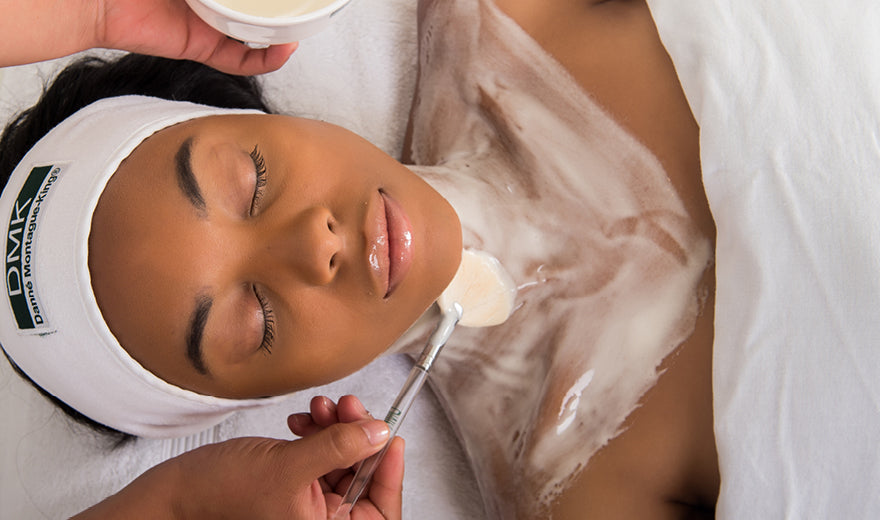
Interested in Enzyme Therapy?
BY DANNÉ MONTAGUE-KING
As featured in Beautify Magazine.
Over the last fifty-six years, I have thought allowing people to list Enzyme Therapy as my signature flagship treatment may have been a mistake. Though it is a system I developed, the treatment was so effective it evoked a series of copycats who tried to imitate my Enzyme Masque formulation as the secret to dealing with all skin anomalies. But copycats try to replicate results without going through scientific research or trial-and-error, often rendering them ineffective.
Understanding enzymes means recognising them as a vital lynchpin of human function. If an alien scientist from beyond Earth appeared before me, demanding a chemical, histological, and pathological description of the human body, I would have a short answer for them. "Well, we are nothing but bags of fluids, a few chemicals orchestrated by enzymes, all held together by an electromagnetic field!". That is what we are. Enzymes' role in the human body is why Enzyme Therapy is essential; we are working with what structures and functions are already there. Enzyme Therapy is often a last resort for people who have tried many creams, pills, and dermatologists to no avail. The difference is that the Enzyme Masque works with the skin, not just on top of it.
ENZYMES AND THE EPIDERMIS
The epidermis is a continuous structure of a heterogeneous type in terms of its anatomical and spatial scale. It is a complex membrane and multilayered shell structure possessing just enough bending stiffness to retain flexibility and structure.
There are three main layers of the skin:
▪ The epidermis is the outermost physical layer of skin that directly interfaces with the outside world. Its primary purpose is to cover and protect us from environmental contaminants with a network of keratinocytes and Langerhans cells, the skin's immune system.
▪ The dermis connects the epidermis to the underlying muscles. It provides structure and nutrients to the epidermis and houses most collagen and elastin fibres that keep the skin healthy. It also contains all the systems that keep the skin oxygenated, supple, and balanced.
▪ The subcutis, also known as the hypodermis, deep adipose, or subcutaneous layer, is formed by a yellowish cover of fatty tissue in the skin's deepest layer. It cushions our inner organs and bone structure, provides thermal regulation, and
stores energy.
Enzymes work by receiving a substrate (the material to be changed), catalysing a reaction, altering that material, and releasing the material for use in the body. For example, when humans digest dairy, the enzyme lactase reacts with the sugar lactose, changing the material into glucose and galactose for easy absorption. Different enzymes can provide targeted results depending on their purpose in the
natural world.
Topical enzymes such as bromalin and papain are naturally derived from pineapple and papaya. Amylase and pancreatin, derived from animals, plants, or fungi, can also be used as a topical enzyme; amylase, in particular, helps permeate biofilms and breaks down carbohydrates. These compounds have been used in the aesthetic industry for over 100 years. I consider them basic 'protein-munching' enzymes; picture a sort of biological Pac-man, eating only dry and dead cells on the epidermal surface. These enzymes are safe and effective in targeting extraneous protein if appropriately formulated (though they can irritate mucous membranes such as the eyes, nostrils, and mouth). DMK often works with bromalin, papain, and amylase in our Prozyme treatments as a safe pre-exfoliant.
Topical enzymes work well to remove protein on the surface, but it is the enzymes native to our skin that are the major players in 'true' and effective Enzyme Therapy. The enzymes in the DMK formula kick-start enzymes in the skin to fight inflammation, loss of firmness, stagnation, dullness, and other skin anomalies contributing to more significant issues
The categories of enzymes in the skin that are triggered to promote homeostasis include:
▪ Oxidoreductases – Enzymes that catalyse the transfer of electrons from an oxidant molecule (the hydrogen or the electron donor) to a reductant molecule (the hydrogen or electron acceptor).
▪ Transferases – Enzymes that catalyse the transfer of a group of atoms, such as amine, carboxyl, carbonyl, methyl, acyl, glycosyl, or phosphoryl, from a donor substrate to an acceptor compound.
▪ Hydrolases – hydrolytic enzymes, which catalyse the cleavage of a covalent bond using water. Hydrolases include esterases, which act on ester bonds; phosphatases, which work on phosphate bonds; proteases, which break down proteins and peptides; and peptidases, which break down peptides into amino acids.
▪ Lysases – Enzymes responsible for catalysing addition and elimination reactions.
▪ Ligases – Enzymes that catalyse the combination of two large molecules. For example, ligase is an enzyme that uses ATP to form bonds in recombinant DNA cloning, which joins restriction endonuclease fragments that have annealed.
ENZYME MASQUE TREATMENT
Proper enzyme treatment takes about an hour, which is fantastic for therapists with multiple clients to prep and attend to. First, a whitish formula, the consistency
of pancake batter, is applied in specific brushstrokes over the face. Then, the formulation needs to sit for a full 45 minutes, where it tightens the skin and
causes a pulsing sensation from increased blood flow and subsequent lymphatic drainage. But triggering these mechanical actions below the skin is worth the
time and effort. As a result, skin cells have excellent oxygen uptake and a clean, fresh matrix to function at their highest capacity, allowing the skin to repair vital
structures below.
After several treatments, the skin has a firmer, lifted look, which is maintainable for the client's life. Of course, clients must also comply with the appropriately diagnosed Home Prescriptives. If clients go home after treatments and slap on just any product—no matter how expensive or hyped—they would negate the effects of the therapy, wasting their money and time.
The 45-minute Enzyme Treatment was designed after much meticulous research over the years. Each 15-minute increment in the 45-minute treatment represents a different phase in the communication between enzymes in the formulation and enzymes in the skin.
The first 15-minute phase is the hydrolysis period, which involves the enzymatic modification of oxidants and extraneous substances. Compounds in the Enzyme
Masque formula send signals that trigger a cascade of actions by Enzymes that exist in the skin. These enzymes transform dead skin cells into a weak acid that can be easily flushed through the lymphatic system.
The second 15-minute phase is Xeno-digestion. It involves the activation of enzymes in the skin that add polar groups to the molecular structures of
unstable products, neutralising them. Essentially, they break down toxins in the skin and prepare them for excretion from the epidermis.
The last 15 minutes of treatment triggers the activation of transporters, which export altered internal and external oxidants and their metabolites from the cell. The exporting process causes downward biophysical and bioelectric pressure; this is aided by the initial Enzyme Masque application, which is applied along Langer Lines (natural lines of skin tension along the body indicating fascia, collagen, and muscle fibres).
A higher-level concept in the skin concerns its piezoelectricity, or the ability of a material to produce an electrical charge in reaction to mechanical stress.
The skin has this quality, and it has been shown that a negative piezoelectric charge has the most significant impact on the tissue's proliferation, growth,
and regeneration. During Enzyme Therapy, the external mechanical stimuli (in the form of repeated brushstroke applications of the Enzyme Masque) generate the piezoelectricity that increases the fixed, negative charge, deforming the damaged collagen molecules and promoting long-term healing. A negative charge is a critical factor in the correct alignment of pro-collagen (baby collagen) fibres
before their maturation into fully developed adult collagen fibres—which, once in the matrix, can "swim up" and bolster the skin where the old, worn-out collagen fibres used to be.

REFLECTIONS
From the beginning of my career, several situations have highlighted how important skincare is and was. For example, once, working out of Belfast, Ireland,
during the RNA attacks, a Marshall came to the clinic door and announced there was a bomb scare alert in the area. All persons were to evacuate the premises.
My estheticians and I moved seven people into the yard behind a pub. My Irish therapists, nonplussed, picked up each trolley with a client and wheeled
them out to the pub yard. Then they calmly finished the treatments! I was only calm because the Irish staff was; inside, I was terrified. All this for Enzyme Therapy. People's dedication to helping others find their normalcy, health, and confidence- even in times of danger- inspired me to continue and underline the importance of the work. And it all started from an Enzyme.
Enzymes are mysterious, powerful, microscopic agents of change that stick with us forever. Like the tenacity of the human spirit, Enzymes are near immortal. They do not die within our lifespans. If we are born with a million enzymes, we leave this life with a million enzymes. I only feel lucky to have seen these mechanisms and unlocked some of their secrets for the good of skin everywhere.

Interested in Enzyme Therapy? Discover more about it here.













